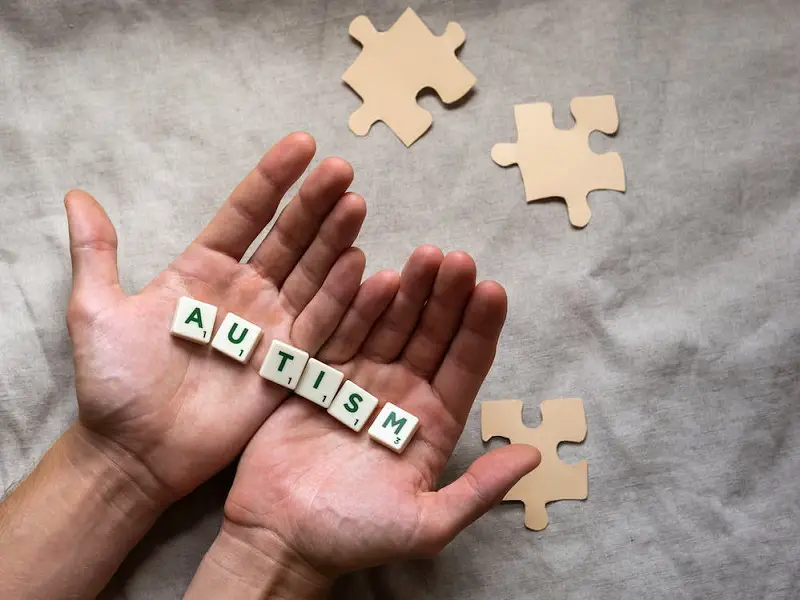Autism is a complex neurological disorder that affects individuals differently, making it difficult to define.
However, a simple definition of autism can be useful in understanding the basics and recognizing how it impacts those affected.
This blog post will provide an overview of what autism is and how it’s commonly characterized.
It will also discuss some of the common signs and symptoms associated with autism, as well as how diagnosis works.
Finally, this article will explore the various types of treatments that are available for individuals with autism.
The Simple Definition of Autism

Autism is a developmental disorder that affects how people communicate and interact with others.
It’s a complex condition with varying degrees of severity, but the simple definition of autism is that it’s a neurological difference that affects socialization, communication, and behavior.
Autism can occur in anyone regardless of ethnicity or gender.
Autism typically becomes apparent in early childhood, where parents may notice their child struggling to make eye contact or engage with others.
Children with autism often have difficulty understanding social cues and may not respond appropriately to gestures or facial expressions.
They can also struggle with verbal communication, which leads to delayed language development or an inability to speak altogether.
While some individuals with autism may excel academically in specific areas such as math or science, they often experience challenges in other areas such as fine motor skills and sensory processing.
However, every person on the autism spectrum is unique and has their own strengths and weaknesses.
Autism is a developmental disorder that affects communication and social interaction. It’s a complex neurological condition that affects people in different ways.
The term “autism” comes from the Greek word “autos,” which means “self.” People with autism tend to have difficulty with social interaction, communication, and repetitive behaviors. Autism is often referred to as a spectrum disorder because it affects people differently.
Autism can be diagnosed in children as young as 18 months old, although many children are not diagnosed until they are much older.
Some of the early signs of autism include delayed speech or language skills, avoiding eye contact, difficulty engaging in play with others, and repeating certain behaviors or actions over and over again.
While there is no cure for autism, early intervention can help children manage their symptoms and improve their quality of life.
The Different Types of Autism
Autism is a developmental disorder that affects communication, social interaction, and behavior. It’s a spectrum disorder, which means that there are different types of autism with varying degrees of symptoms.
The first type of autism is Classical Autism or Kanner’s Syndrome.
This type is characterized by delayed language development, difficulty in social interactions, repetitive behaviors or routines, and a lack of interest in playing with others.
The second type of autism is Asperger’s Syndrome. People with this type have average to above-average intelligence but struggle with social interactions and nonverbal cues.
They may also show an intense interest in specific subjects or activities. Another type of autism is Pervasive Developmental Disorder – Not Otherwise Specified (PDD-NOS).
This diagnosis was given to individuals who demonstrated some but not all the symptoms required for classical autism or Asperger’s syndrome.
Symptoms of Autism

It can be difficult to identify autism in children since its symptoms vary widely and can range from mild to severe.
Knowing the signs and symptoms of autism is important in order to get an accurate diagnosis and the best available treatments.
This section provides an overview of some of the common symptoms associated with autism spectrum disorder (ASD).
I. Social Interaction and Communication
Social interaction and communication are crucial aspects of human life. They enable people to connect and share ideas, experiences, and emotions.
However, for individuals with autism spectrum disorder (ASD), social interaction and communication can be difficult.
This is because people with ASD often have difficulties understanding social cues such as body language, tone of voice, and facial expressions.
One of the earliest signs of autism is delayed or absent speech. Children with ASD may struggle to communicate their needs or feelings through spoken words or nonverbal cues such as gestures or facial expressions.
As a result, they may seem withdrawn, uninterested in peers, avoid eye contact, or not respond when called by name.
These behaviors can be misconstrued as shyness or disinterest but are likely due to difficulties in social interaction. Individuals with autism often find it challenging to form and maintain relationships with others.
II. Repetitive Behaviors
Repetitive behaviors are often associated with autism and can serve as an early indicator of the disorder. These behaviors, also known as stereotypies, involve repeating the same actions or movements over and over again.
Stereotypies can include hand-flapping, body-rocking, spinning objects, lining up toys in a specific order or pattern, or repeating certain words or phrases.
While repetitive behaviors are not exclusive to autism and can occur in other disorders such as obsessive-compulsive disorder (OCD) or attention-deficit/hyperactivity disorder (ADHD), they can be more pronounced in individuals with autism.
These behaviors may serve as a way for individuals with autism to cope with stress or anxiety by providing a sense of comfort and control.
It is important to note that not all individuals with autism exhibit repetitive behaviors and that their presence alone does not necessarily indicate the disorder.
III. Sensory Sensitivities
Sensory sensitivities are a common sign of autism in children. These sensitivities can manifest in various ways, including heightened sensitivity to sounds, textures, tastes, and smells.
Children with autism may become overwhelmed by certain sensory stimuli that other children would not even notice or find bothersome.
For example, some children with autism may be extremely sensitive to bright lights or loud noises and may become distressed when exposed to these stimuli.
Others may have difficulty tolerating certain textures on their skin or certain foods in their mouths. These sensitivities can make it difficult for children with autism to participate in everyday activities such as going to school or attending social events.
It’s important for parents and caregivers to understand the role that sensory sensitivities play in the lives of children with autism.
By recognizing these sensitivities and finding ways to accommodate them, parents can help their children thrive despite the challenges posed by their condition.
Causes of Autism
Autism is a complex neurological disorder that affects a person’s ability to communicate and interact socially.
Though it has been long known that genetics play a role in the development of autism, the specific causes remain largely unknown.
Research suggests there may be multiple factors involved in the development of this condition.
In this section, we will explore some of the potential causes of autism, including genetic and environmental factors.
1. Genetics
Autism is a complex neurodevelopmental disorder that affects the communication and social interaction abilities of an individual.
Although the exact causes of autism remain unknown, genetics have been identified as one of the primary contributing factors.
Genetic mutations or changes can lead to disruptions in normal brain development and function, resulting in autism.
Research has shown that there are hundreds of genes associated with autism, and variations in these genes can increase an individual’s risk of developing the disorder.
Some genetic syndromes, such as Fragile X syndrome or Rett syndrome, are also known to cause autism.
Additionally, studies have revealed that siblings and other family members of individuals with autism are more likely to develop the condition themselves due to shared genetic factors.
However, it is important to note that genetics alone do not determine whether an individual will develop autism.
2. Environmental Factors
Autism, also known as ASD (Autism Spectrum Disorder), is a neurological condition that affects the development of social and communication skills.
Autism has been on the rise in recent years, and researchers have long been trying to understand why. While genetics play a significant role in autism, studies have shown that environmental factors are also responsible for the disorder’s prevalence.
Environmental factors refer to any external influence that affects an individual’s health. Exposure to certain chemicals such as pesticides, lead, and methylmercury can increase the risk of developing autism.
Research has found that pregnant women who are exposed to air pollution during their first trimester have a higher chance of having children with autism.
Other environmental factors include maternal infections during pregnancy, low birth weight, and premature birth. A study conducted by Harvard University found that babies born less than 37 weeks were more likely to develop autism than those born after 37 weeks.
3. Brain Development
Autism is a neurodevelopmental condition that affects communication, social interaction, and behavior. While the exact causes of autism are still being researched, there is growing evidence to suggest that brain development plays a significant role in its onset.
In fact, studies have shown that abnormalities in brain structure and function can occur very early on during fetal development.
One of the primary ways in which brain development can cause autism is through problems with neuronal connectivity.
Neurons need to be able to communicate with each other effectively in order for the brain to function properly.
However, if there are disruptions or delays in this process, it can lead to cognitive and behavioral impairments commonly seen in individuals with autism spectrum disorders (ASD).
Furthermore, certain areas of the brain may develop differently or at different rates than others, which can also contribute to ASD symptoms.
Treatment and Support for Autism

Autism is a complex neurological disorder that affects social interaction and communication. It’s estimated that 1 in every 54 children is diagnosed with autism in the United States.
The good news is that there are various treatments and support options available to those living with autism, as well as their families.
This section will provide an overview of the different treatment options and forms of support available for those on the autism spectrum.
With proper education, treatment, and support, people living with autism can lead successful and fulfilling lives.
I. Behavioral and Communication Therapies
Autism is a developmental disorder that affects an individual’s ability to communicate and interact with others. It is not a disease but rather a complex neurological condition that varies in degree from person to person.
There is no known cure for autism, but there are treatments and therapies available that can help individuals with the condition lead fulfilling lives. Behavioral and communication therapies have proven to be effective in treating and supporting those with autism.
Behavioral therapy focuses on changing certain behaviors by using positive reinforcement techniques. This approach helps individuals understand what actions are expected of them and rewards them when they exhibit those behaviors.
This type of therapy can be used to teach social skills, language development, self-help skills, and academic skills. Communication therapy focuses on improving an individual’s ability to communicate effectively with others through verbal or nonverbal means.
II. Medications
Medications for autism treatment and support can be a crucial part of managing the symptoms associated with this neurodevelopmental disorder.
Although there is no cure for autism, medications can help individuals manage their behavior, emotions, and other challenges that come with the condition.
It’s important to note that medication is just one tool in the toolbox of autism treatment; behavioral therapy and educational interventions are also critical.
There are several types of medications used to treat autism spectrum disorders. Some focus on reducing anxiety or depression, while others control aggression or hyperactivity.
There are also medications prescribed to help individuals struggling with sleep problems or seizures – two common issues faced by people with ASD.
It’s essential to work closely with your healthcare provider when considering medication options for autism treatment and support.
Each person with autism is unique, so there is no one-size-fits-all approach when it comes to medication management.
III. Supportive Services and Resources
If you are a parent or caregiver of a child with autism, you understand how challenging it can be to meet their unique needs.
Fortunately, there are numerous support services and resources available to help manage the symptoms of autism and provide support along the way.
One essential resource is early intervention programs that address developmental delays in children with autism.
These programs provide individualized treatment plans that incorporate behavioral therapy, speech therapy, occupational therapy, and other interventions depending on the child’s specific needs.
The goal is to improve communication skills, social interaction, and overall behavior to help them reach their full potential.
Another supportive service for families affected by autism is respite care. Caring for a child with autism can be exhausting both physically and emotionally.
Respite care gives parents or caregivers a break by providing professional assistance in caring for their loved ones temporarily.
Living with Autism (The Challenges & How to Cope)

Living with Autism is an incredibly challenging experience both for those who have it and those around them.
It’s a lifelong developmental disorder that affects how people interact with the world and others around them.
People with autism often have difficulty communicating and forming relationships.
Despite the challenges, living with autism can also be rewarding as there are many supports available to help those living with autism lead meaningful lives.
Through personal stories and expert advice, this section seeks to provide valuable insight into living with autism as well as strategies for managing its effects.
1. Challenges and Opportunities
Living with autism can present both challenges and opportunities for individuals with the condition and their loved ones.
The challenges of living with autism may include difficulty communicating, sensory sensitivities, and social isolation.
These difficulties can make it challenging for individuals on the autism spectrum to navigate daily life activities such as school, work, and social situations.
However, there are also many opportunities that come with living with autism. Many individuals on the spectrum have unique strengths and talents in areas such as music, art, mathematics, or science.
It’s essential to focus on these positives rather than just the struggles that come along with a diagnosis of autism.
With support from family members and professionals trained in working with autistic individuals, those living with this condition can learn to manage their challenges effectively while embracing their strengths.
Overall, it is important to recognize that living with autism presents both obstacles and possibilities.
2. Strategies for Success
Living with autism can be challenging, but there are strategies you can use to help yourself or a loved one succeed. The first strategy is to develop a routine that works for you.
Consistency is key when it comes to living with autism and having a predictable schedule can reduce stress and anxiety.
It’s also important to create an environment that promotes calmness, such as using low lighting or soft music.
Another effective strategy is to communicate clearly and effectively. People on the autism spectrum may struggle with social interactions, so it’s important to work on communication skills.
This could involve using visual aids like picture schedules or gesture-based communication methods like sign language. Additionally, practicing active listening can improve your ability to understand others’ intentions and emotions.
Finally, self-care should not be overlooked when living with autism. Taking care of your physical and emotional needs will contribute significantly towards success in daily life.
3. Advocacy and Awareness
Advocacy and Awareness for living successfully with autism are essential components that can make a significant difference in the lives of individuals with Autism Spectrum Disorder (ASD).
ASD is a complex neurodevelopmental disorder that affects communication, social interaction, and behavior. It is estimated that one in 54 children in the United States has ASD.
Unfortunately, many individuals with ASD face challenges such as discrimination, lack of access to education and healthcare services, and difficulties finding employment.
Advocacy for people with ASD involves promoting their rights and equal opportunities while raising awareness about their unique abilities.
Advocates work towards creating an inclusive environment where individuals on the spectrum can thrive. This could include advocating for policies that promote inclusion or lobbying for changes in school curricula to ensure they meet the needs of students on the spectrum.
What is the Meaning of An Autistic Child?

Autism is a neurodevelopmental disorder that affects communication, social interaction, and behavior. It is a complex condition that manifests itself in different ways in individuals with autism spectrum disorder (ASD).
The meaning of an autistic child goes beyond the surface symptoms of the disorder. It encompasses their unique perspective on the world and their potential contributions to society.
An autistic child may struggle with sensory processing difficulties, which can make them overly sensitive to certain sounds or textures.
They may also experience challenges with communication, such as difficulty understanding social cues or expressing themselves verbally.
However, these challenges do not define who they are as a person. Autistic children have their own strengths and talents that should be celebrated.
The meaning of an autistic child lies in their ability to see the world from a different perspective than most people. They often have a keen eye for detail and can pick up on patterns that others might miss.
Autism in Adults

Autism in adults is a condition that affects millions of people around the world.
Despite being commonly associated with children, autism spectrum disorder (ASD) can persist into adulthood and have a significant impact on an individual’s life.
Adults with autism may experience difficulty in social interactions, communication, and behavior patterns.
One of the main challenges faced by adults with autism is finding employment opportunities.
Many employers are not aware of the unique strengths and skills that individuals with ASD possess, making it difficult for them to secure jobs.
Furthermore, some autistic adults may struggle with job interviews due to difficulties in communication and social interaction.
Another challenge faced by autistic adults is accessing appropriate healthcare services.
Due to a lack of understanding among healthcare professionals, many autistic individuals do not receive adequate support for their specific needs.
This can lead to mental health issues such as anxiety and depression which can be exacerbated by the lack of tailored care available.
The Simple Definition of Autism (Summary)
Autism is a complex neurological disorder that affects the way an individual communicates and interacts with others. It can range from mild to severe and manifests itself in many different ways.
While there is no cure for autism, individuals on the spectrum can still lead meaningful, rewarding lives with proper support from family and professionals.
Understanding autism is key to providing necessary accommodations, acceptance, inclusion, and respect for those living with this disability.
If you’ve made it this far on this web page, we hope that by now, you should understand the simple definition of autism, and its effect on the people living with it, and those around them.
Other Blog Posts
